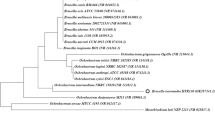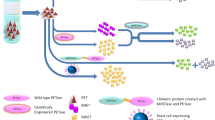Abstract
Direct combustion of sulfur-enriched liquid fuel oil causes sulfur oxide emission, which is one of the main contributors to air pollution. Biodesulfurization is a promising and eco-friendly method to desulfurize a wide range of thiophenic compounds present in fuel oil. Previously, numerous bacterial strains from genera such as Rhodococcus, Corynebacterium, Gordonia, Nocardia, Mycobacterium, Mycolicibacterium, Paenibacillus, Shewanella, Sphingomonas, Halothiobacillus, and Bacillus have been reported to be capable of desulfurizing model thiophenic compounds or fossil fuels. In the present study, we report a new desulfurizing bacterium, Tsukamurella sp. 3OW, capable of desulfurization of dibenzothiophene through the carbon–sulfur bond cleavage 4S pathway. The bacterium showed a high affinity for the hydrocarbon phase and broad substrate specificity towards various thiophenic compounds. The overall genome-related index analysis revealed that the bacterium is closely related to Tsukamurella paurometabola species. The genomic pool of strain 3OW contains 57 genes related to sulfur metabolism, including the key dszABC genes responsible for dibenzothiophene desulfurization. The DBT-adapted cells of the strain 3OW displayed significant resilience and viability in elevated concentrations of crude oil. The bacterium showed a 19 and 37% reduction in the total sulfur present in crude and diesel oil, respectively. Furthermore, FTIR analysis indicates that the oil's overall chemistry remained unaltered following biodesulfurization. This study implies that Tsukamurella paurometabola species, previously undocumented in the context of biodesulfurization, has good potential for application in the biodesulfurization of petroleum oils.










Similar content being viewed by others
Data availability
The data presented in the study are deposited in the NCBI SRA repository (BioProject number PRJNA726364) and GenBank/ENA/DDBJ genetic sequence database (WGS accession JAGXOE000000000).
References
Agarwal P, Sharma DK (2010) Comparative studies on the bio-desulfurization of crude oil with other desulfurization techniques and deep desulfurization through integrated processes. Energy fuels 24:518–524
Agency for Toxic Substances and Disease Registry (ATSDR), Toxicological profile for sulfur dioxide. (1998) ttps://wwwn.cdc.gov/TSP/ToxProfiles/ToxProfiles.aspx?id=253&tid=46
Aggarwal S, Karimi IA, Ivan GR (2013) In silico modeling and evaluation of Gordonia alkanivorans for biodesulfurization. Mol Biosyst 9:2530–2540
Akhtar N, Ghauri MA, Akhtar K (2016) Dibenzothiophene desulfurization capability and evolutionary divergence of newly isolated bacteria. Arch Microbiol 198:509–519
Akhtar N, Ghauri MA, Anwar MA, Akhtar K (2009) Analysis of the dibenzothiophene metabolic pathway in a newly isolated Rhodococcus spp. FEMS Microbiol Lett 301:95–102
Akram J, Parveen S, Akhtar N (2021) Isolation and characterization of thiophenic sulfur metabolizing bacteria from oil contaminated soil samples. In: 2021 International Bhurban conference on applied sciences and technologies (IBCAST). IEEE, pp 458–463
Alves L, Salgueiro R, Rodrigues C, Mesquita E, Matos J, Gírio FM (2005) Desulfurization of dibenzothiophene, benzothiophene, and other thiophene analogs by a newly isolated bacterium, Gordonia alkanivorans strain 1B. Appl Biochem Biotechnol 120:199–208
Aziz RK, Bartels D, Best AA, DeJongh M, Disz T, Edwards RA, Zagnitko O (2008) The RAST server: rapid annotations using subsystems technology. BMC genomics 9:1–15
Bachmann RT, Johnson AC, Edyvean RG (2014) Biotechnology in the petroleum industry: an overview. Int Biodeterior Biodegradation 86:225–237
Carvajal P, Dinamarca MA, Baeza P, Camú E, Ojeda J (2017) Removal of sulfur-containing organic molecules adsorbed on inorganic supports by Rhodococcus rhodochrous spp. Biotechnol Lett 39:241–245
Chen S, Zang M, Li L, Chen J, Liu Q, Feng X, Zhao C (2021) Efficient biodesulfurization of diesel oil by Gordonia sp. SC-10 with highly hydrophobic cell surfaces. Biochem Eng J 174:108094
De Carvalho CC, Da Cruz AA, Pons MN, Pinheiro HM, Cabral JM, Da Fonseca MMR, Fernandes P (2004) Mycobacterium sp., Rhodococcus erythropolis, and Pseudomonas putida behavior in the presence of organic solvents. Microsc Res Tech 64:215–222
Debabov VG (2010) Microbial desulfurization of motor fuel. Appl Biochem Microbiol 46:733–738
Gray KA, Pogrebinsky OS, Mrachko GT, Xi L, Monticello DJ, Squires CH (1996) Molecular mechanisms of biocatalytic desulfurization of fossil fuels. Nat Biotechnol 14:1705–1709
Gupta N, Roychoudhury PK, Deb JK (2005) Biotechnology of desulfurization of diesel: prospects and challenges. Appl Microbiol Biotechnol 66:356–366
Hamamura N, Olson SH, Ward DM, Inskeep WP (2006) Microbial population dynamics associated with crude-oil biodegradation in diverse soils. Appl Environ Microbio. 72:6316–6324
Kaczorek E, Pijanowska A, Olszanowski A (2008) Yeast and bacteria cell hydrophobicity and hydrocarbon biodegradation in the presence of natural surfactants: rhamnolipides and saponins. Bioresour Technol 99:4285–4291
Khan MR, Al-Sayed E (2007) Hydrocarbon desulfurization to clean fuels by selective oxidation versus conventional hydrotreating. Energy sources, part A: recovery, Util Environ Eff 30:200–217
Kilbane JJ II (2006) Microbial biocatalyst developments to upgrade fossil fuels. Curr Opin Biotechnol 17:305–314
Kilbane JJ II, Le Borgne S (2004) Petroleum biorefining: the selective removal of sulfur, nitrogen, and metals. Stud Surf Sci Catal 151:29–65
Le Borgne S, Quintero R (2003) Biotechnological processes for the refining of petroleum. Fuel Process Technol 81:155–169
Li MZ, Squires CH, Monticello DJ, Childs JD (1996) Genetic analysis of the dsz promoter and associated regulatory regions of Rhodococcus erythropolis IGTS8. J Bacteriol 178:6409–6418
Meier-Kolthoff JP, Göker M (2019) TYGS is an automated high-throughput platform for state-of-the-art genome-based taxonomy. Nat Commun 10:2182
Mohamed MES, Al-Yacoub ZH, Vedakumar JV (2015) Biocatalytic desulfurization of thiophenic compounds and crude oil by newly isolated bacteria. Front Microbiol 6:112
Mohebali G, Ball AS (2016) Biodesulfurization of diesel fuels–past, present and future perspectives. Int Biodeterior Biodegradation 110:163–180
Monticello DJ (2000) Biodesulfurization and the upgrading of petroleum distillates. Curr Opin Biotechnol 11:540–546
Monticello DJ, Finnerty WR (1985) Microbial desulfurization of fossil fuels. Annu Rev Microbiol 39:371–389
Ostro B, Tobias A, Querol X, Alastue A, Amato F, Pey J, Perez N, Sunyer J (2011) The effects of particulate matter sources on daily mortality: a case-crossover study of Barcelona, Spain. Environ Health Perspect 119:1781–1787
Pal S, Kundu A, Banerjee TD, Mohapatra B, Roy A, Manna R et al (2017) Genome analysis of crude oil degrading Franconibacter pulveris strain DJ34 revealed its genetic basis for hydrocarbon degradation and survival in oil contaminated environment. Genomics 109:374–382
Parveen S, Akhtar N, Ghauri MA, Akhtar K (2020) Conventional genetic manipulation of desulfurizing bacteria and prospects of using CRISPR-Cas systems for enhanced desulfurization activity. Crit Rev Microbiol 46:300–320
Piddington CS, Kovacevich BR, Rambosek J (1995) Sequence and molecular characterization of a DNA region encoding the dibenzothiophene desulfurization operon of Rhodococcus sp. strain IGTS8. Appl Environ Microbiol 61:468–475
Sadare OO, Obazu F, Daramola MO (2017) Biodesulfurization of petroleum distillates—current status, opportunities and future challenges. Environ 4:85
Saleh TA (2020) Environmental concerns and the importance of desulfurization. In: Nanocomposites for the desulfurization of fuels. IGI Global, pp 284–294
Silva TP, Alves L, Paixao SM (2020) Effect of dibenzothiophene and its alkylated derivatives on coupled desulfurization and carotenoid production by Gordonia alkanivorans strain 1B. J Environ Manage 270:110825
Song C (2003) An overview of new approaches to deep desulfurization for ultra-clean gasoline, diesel fuel and jet fuel. Cat Today 86:211–263
Tanaka Y, Matsui T, Konishi J, Maruhashi K, Kurane R (2002) Biodesulfurization of benzothiophene and dibenzothiophene by a newly isolated Rhodococcus strain. Appl Microbiol Biotechnol 59:325–328
Wang W, Ma T, Lian K, Zhang Y, Tian H, Ji K, Li G (2013) Genetic analysis of benzothiophene biodesulfurization pathway of Gordonia terrae strain C-6. PLoS One 8:e84386
Wei SN, Li YF, Jeong EC, Kim HJ, Kim JG (2021) Effects of formic acid and lactic acid bacteria inoculant on main summer crop silages in Korea. J Anim Sci Technol 63:91
Wu P, Lu L, He J, Chen L, Chao Y, He M, Zhu F, Chu X, Li H, Zhu W (2020) Hexagonal boron nitride: a metal-free catalyst for deep oxidative desulfurization of fuel oils. Green Energy Environ 5:166–172
Yoon SH, Ha SM, Kwon S, Lim J, Kim Y, Seo H, Chun J (2017) Introducing EzBioCloud: a taxonomically united database of 16S rRNA gene sequences and whole-genome assemblies. Int J Syst Evol Microbiol 67:1613
Yu B, Xu P, Shi Q, Ma C (2006) Deep desulfurization of diesel oil and crude oils by a newly isolated Rhodococcus erythropolis strain. Appl Environ Microbiol 72:54–55
Acknowledgments
The authors are grateful to Dr. Muhammad Farooq (Principal Scientist, NIBGE) for his assistance in assembling the bacterial genome sequence.
Funding
This research work was supported by the International Foundation for Science (IFS), Stockholm, Sweden (agreement no. F-5379-2) and the Higher Education Commission (HEC) of Pakistan (research project no. NRPU-11570).
Author information
Authors and Affiliations
Contributions
Javeria Akram: Experimentation, Formal analysis, Visualization, Writing. Muhammad Umar Hussain: Experimentation, Visualization, Metabolite extraction, HPLC/MS analysis, Writing. Asma Aslam: Experimentation, Formal analysis, Data interpretation, Writing-basic draft. Kalsoom Akhtar: Visualization, Review &; Editing. Munir Ahmad Anwar: Proof reading- Review &; Editing. Mazhar Iqbal: LC/MS analysis &; data interpretation. Muhammad Tahir Hussain: Sampling, Investigation, Crude and diesel oil analysis, Nasrin Akhtar: Conceptualization, Supervision, Project administration, Funding acquisition, Resources, Writing-original draft, Writing-review &; editing.
Corresponding author
Ethics declarations
Ethics approval and consent to participate
Not applicable
Consent for publication
Not applicable
Competing interests
The authors declare no competing interests.
Additional information
Publisher’s note
Springer Nature remains neutral with regard to jurisdictional claims in published maps and institutional affiliations.
Supplementary information
ESM 1
(DOCX 404 kb)
Rights and permissions
Springer Nature or its licensor (e.g. a society or other partner) holds exclusive rights to this article under a publishing agreement with the author(s) or other rightsholder(s); author self-archiving of the accepted manuscript version of this article is solely governed by the terms of such publishing agreement and applicable law.
About this article
Cite this article
Akram, J., Hussain, M.U., Aslam, A. et al. Genomic analysis and biodesulfurization potential of a new carbon–sulfur bond cleaving Tsukamurella sp. 3OW. Int Microbiol (2024). https://doi.org/10.1007/s10123-024-00484-z
Received:
Revised:
Accepted:
Published:
DOI: https://doi.org/10.1007/s10123-024-00484-z




